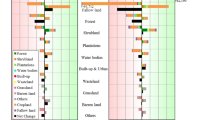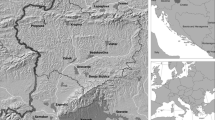Abstract
The “neoliberal period” witnessed some of the largest forest clearing in Latin America, particularly in the relatively untouched eastern lowlands of sub-tropical Bolivia. This paper shows through the use of satellite imagery analysis that ~10,000 km2 of forest were cleared during this time period (1986–2006) from an area of forest measuring ~55,000 km2. It also shows through the use of semi-structured interviews that the role and the rationale of the individual producer was equally if not more important than structural adjustment policies and their accompanying effects in driving these changes. Producers decisions of how to use the land are influenced by their background and knowledge of production systems (“tradition”), physical and climatic factors, crops which require relatively little input and are easy to cultivate, soil and tillage factors, concerns over quantity of production, and government policies. The importance of this study lies in the fact that the factors which play an important role in land-use and land-cover change are complex and multivariable and include individual decisions of the producer which are sometimes external to the market and other outside influences. This study could possibly serve as an exemplar and a warning that conservationists and policy-makers should take heed of in the future. By focusing solely on macro-economic policies, we can often overlook the individual producer and their decision-making capacity to alter the landscape.



Similar content being viewed by others
Notes
In its most basic form, neoliberalism has been defined as a political philosophy or worldview of free markets and less government (Liverman and Vilas 2006: 329). This philosophy or view is built on the argument that less government intervention will lead to a more efficient market and therefore, greater economic growth (Stiglitz 2002). For a more thorough description of origins, components, and implementation in Latin America, see Gwynne and Kay (2000).
For this study, I have defined “decision-making” as the process whereby individual producers (i.e., farmers) decide on a course of action based on other possible alternatives. The result or choice can be based on action or opinion, regardless whether the choice is seen as rational or irrational since the producer has no advance knowledge of the consequences. This study largely takes into account the “psychological perspective” of decision making whereby I examine individual decisions in the context of a set of needs, preferences an individual has and values they seek (Kahneman and Tversky 2000).
High-input, high-output agricultural systems have been previously described by Brannstrom (2009) for southern Brazil, and are synonymous with ‘modern agriculture’ (Pretty et al. 2001) or ‘industrial agriculture’ (Horrigan et al. 2002; Wilson 2001). Under either name, crop production is typified by large amounts of inputs relying on outside industries to supply labor, tractors and irrigation equipment, fertilizers, pesticides, herbicides, modified seeds, and fuel, in an effort to maximize yields for commercial export (Pimentel et al. 1973).
Created by the Santa Cruz Natural Resources Protection Project and funded by the World Bank in the mid-1990s, the PLUS map was designed to plan development in Santa Cruz by taking into account precipitation and soil fertility, depth, texture, slope, salinity and chemical toxicity. It is still closely followed by government agencies and producer associations.
The elbow of the Andes (or Arica elbow) is a geographical location at roughly 18°S where the orientation of the Andes begins to trend from southeast to a more southerly direction. The bend creates changes in topography, atmospheric wind patterns, local air circulation, and decreasing rainfall moving south.
Respondents stated that certain crops are relatively low input. Of course, this depends upon what the comparison is. For example, cotton is one of the most chemically intensive crops grown in many parts of the world. However, I chose to leave this list as written since these were original responses noted by the interviewees.
References
Aide, T. M., & Grau, H. R. (2004). Globalization, migration and Latin American ecosystems. Science, 305(5692), 1915–1916.
ANAPO (Asociación De Productores De Oleaginosas Y Trigo [Association of Oilseed and Wheat Producers]). (2008). Memoria annual–2008. Bolivia: Santa Cruz.
Bank, World. (1990). Sustainable development, issues in adjustment lending policies. divisional paper no. 1989–6. Washington, D.C.: Environment Department, Policy and Research Division.
Borrow–Strain, A. (2007). Intimate enemies: Landowners power, and violence in Chiapas, Mexico. Durham, NC and London, UK: Duke University Press.
Brannstrom, C. B. (2009). South America’s neoliberal agricultural frontiers: places of environmental sacrifice or conservation opportunity. Ambio, 38(3), 141–149.
Charmaz, K. (2001). Grounded theory. In R. M. Emerson (Ed.), Contemporary field research: Perspectives and formulations (pp. 335–352). Long Grove, IL: Waveland Press.
Chavez, P. S. (1996). Image–based atmospheric corrections revisited and improved. Photogrammetric Engineering and Remote Sensing, 62(9), 1025–1036.
Davies, D. (1993). Estimation of deforestation east of the Rio Grande, Bolivia, using Landsat satellite imagery. Unpublished Master’s Thesis, Cranfield Institute of Technology, Silsoe, UK: Silsoe College.
Ferguson, M. A. D., & Messier, F. (1997). Collection and analysis of traditional ecological knowledge about a population of Arctic Tundra Caribou. Arctic, 50(1), 17–28.
Geist, H. J., & Lambin, E. F. (2004). Dynamic causal patterns of desertification. BioScience, 54(9), 817–829.
Gwynne, R. N., & Kay, C. (2000). Views from the periphery: Futures of neoliberalism in Latin America. Third World Quarterly, 21(1), 141–156.
Hecht, S. B. (2005). Soybeans, development and conservation on the Amazon frontier. Development and Change, 36(2), 375–404.
Horrigan, L., Lawrence, R. S., & Walker, P. (2002). How sustainable agriculture can address the environmental and human health harms of industrial agriculture. Environmental Health Perspectives, 110(5), 445–456.
Jensen, J. R. (2005). Introductory digital image processing. New Jersey: Pearson Prentice Hall.
Kahneman, D., & Tversky, A. (2000). Choice, values, frames. Cambridge, UK: The Cambridge University Press.
Kaimowitz, D. (1997). Factors determining low deforestation: The Bolivian Amazon. Ambio, 26(8), 537–540.
Kaimowitz, D., Ndoye, E. O., Pacheco, P., & Sunderlin, W. D. (1998). Considering the impact of structural adjustment policies on forests in Bolivia, Cameroon and Indonesia. Unasylva, 49, 57–64.
Kaimowitz, D., Thiele, G., & Pacheco, P. (1999). The effects of structural adjustment on deforestation and forest degradation in lowland Bolivia. World Development, 27(3), 505–520.
Killeen, T. J. (2007). A perfect storm in the Amazon wilderness: Development and conservation in the context of the initiative for the integration of the regional infrastructure of South America (IIRSA). Arlington, VA: Center for Applied Biodiversity Science (CABS), Conservation International.
Killeen, T. J., Calderon, V., Soria, L., Quezada, B., Steininger, M. K., Harper, G., et al. (2007). Thirty years of land–cover change in Bolivia. Ambio, 36(7), 600–606.
Killeen, T. J., Guerra, A., Calzada, M., Correa, L., Calderon, V., Soria, L., et al. (2008). Total historical land–use change in Eastern Bolivia: Who, where, when, and how much? Ecology and Society, 13(1), 36.
Klak, T. (2008). Neoliberal exports and regional vulnerability. In E. L. Jackiewicz & F. J. Bosco (Eds.), Placing Latin America: Contemporary themes in human geography (pp. 31–49). Lanham, MD: Rowman and Littlefield Publishers.
Lambin, E. F., & Meyfroidt, P. (2010). Land use transitions: Socio-ecological feedback versus socio-economic change. Land Use Policy, 27(2), 108–118.
Lanning, J. W. (1971). The old colony mennonites of Bolivia. Unpublished Master’s Thesis, College Station, TX: Texas A & M University.
Liverman, D. M., & Vilas, S. (2006). Neoliberalism and the environment in Latin America. Annual Review of Environment and Resources, 31(1), 327–363.
Mertens, B., Kaimowitz, D., Puntodewo, A., Vanclay, J., & Mendez, P. (2004). Modeling deforestation at distinct geographic scales and time periods in Santa Cruz, Bolivia. International Regional Science Review, 27(3), 271–296.
Neis, B., Schneider, D. C., Felt, F., Haedrich, R. L., Fischer, J., & Hutchings, J. A. (1999). Fisheries assessment: What can be learned from interviewing resource users? Canadian Journal of Fisheries and Aquatic Sciences, 56(10), 1949–1963.
Pacheco, P. (1998). Estilos de desarrollo, deforestación y degradación de los bosques en las tierras bajas de Bolivia. La Paz, Bolivia: CIFOR (Center for International Forestry Research), Centro de Estudios para el Desarrollo Laboral (CEDLA), and Agrario, Teller de Iniciativas en Estudios Rurales y Reforma Agraria (TIERRA).
Pacheco, P. (2006). Agricultural expansion and deforestation in lowland Bolivia, the import substitution versus the structural adjustment model. Land Use Policy, 23(3), 205–225.
Pimentel, D., Hurd, L. E., Bellotti, A. C., Forster, M. J., Oka, I. N., Sholes, O. D., et al. (1973). Food production and the energy crisis. Science, 182(4111), 443–449.
Pretty, J., Brett, C., Gee, D., Hine, R., Mason, C., Morison, J., et al. (2001). Policy challenges and priorities for internalizing the externalities of modern agriculture. Journal of Environment and Planning, 44(2), 263–283.
Redo, D. (In Press). Mapping land–use and land–cover change along Bolivia’s Corredor Bioceánico with CBERS and Landsat: 1975–2008. International Journal of Remote Sensing.
Redo, D., & Millington, A. C. (2011). A hybrid approach to mapping land–use modification and land–cover transition from MODIS time–series data: A case study from the Bolivian seasonal tropics. Remote Sensing of the Environment, 115(2), 353–372.
Redo, D., Millington, A. C., & Hindery, D. (2011). Deforestation dynamics and policy changes in Bolivia’s post–neoliberal era. Land Use Policy, 28(1), 227–241.
Rudel, T. K. (2007). Changing agents of deforestation: From state–initiated to enterprise driven processes, 1970–2000. Land Use Policy, 24(1), 35–41.
Steininger, M. K., Tucker, C. J., Ersts, P., Killeen, T. J., Villegas, Z., & Hecht, S. B. (2001a). Clearance and fragmentation of tropical deciduous forest in the Tierras Bajas, Santa Cruz, Bolivia. Conservation Biology, 15(4), 856–866.
Steininger, M. K., Tucker, C. J., Townsend, J. R. G., Killeen, T. J., Desch, A., Bell, V., et al. (2001b). Tropical deforestation in the Bolivian Amazon. Environmental Conservation, 28(2), 127–134.
Stiglitz, J. (2002). Globalization and its discontents. New York, NY: W.W. Norton and Company.
Tucker, C. J., & Townshend, J. R. G. (2000). Strategies for monitoring tropical deforestation using satellite data. International Journal of Remote Sensing, 21(6&7), 1461–1471.
Urioste, M. (2011). Concentración y extranjerización de la tierra en Bolivia. La Paz, Bolivia: TIERRA.
Wilson, G. A. (2001). Productivism and to post–productivism…and back again? Exploring the (un)changed natural and mental landscapes of European agriculture. Transactions of the Institute of British Geographers, 26(1), 77–102.
World Bank. (2005). Development policy lending and forest outcomes: Influences, interactions, and due diligence. Report no. 32724–GLB. Washington, D.C.: The World Bank Agriculture and Rural Development Department.
Zoomers, A. (2003). Land liberalisation and sustainable development in Latin America. International Development Planning Review, 25(3), 245–262.
Acknowledgments
This study was funded by the National Science Foundation, SBE DDRI Geography and Regional Science and Office of International Science and Engineering (Grant: BCS–0802672), and was additionally funded by Texas A&M University. I sincerely thank both institutions for their support as well the anonymous reviewers whose comments and suggestions helped to significantly improve this manuscript. I also thank the Human–Environment Group at Texas A&M, particularly Dr. Christian Brannstrom, and Dr. Mitchell Aide of the University of Puerto Rico for their valuable advice during the early drafts. My particular thanks to Phil Bender who patiently set up interviews with farmers, producer organizations, helped with the inevitable translation issues, and helped me to achieve one of my holy grails––to interview Mennonite farmers.
Author information
Authors and Affiliations
Corresponding author
Rights and permissions
About this article
Cite this article
Redo, D. The role of the individual producer in driving land change: the case of Santa Cruz, Bolivia, 1986–2006. GeoJournal 78, 69–84 (2013). https://doi.org/10.1007/s10708-011-9432-8
Published:
Issue Date:
DOI: https://doi.org/10.1007/s10708-011-9432-8




